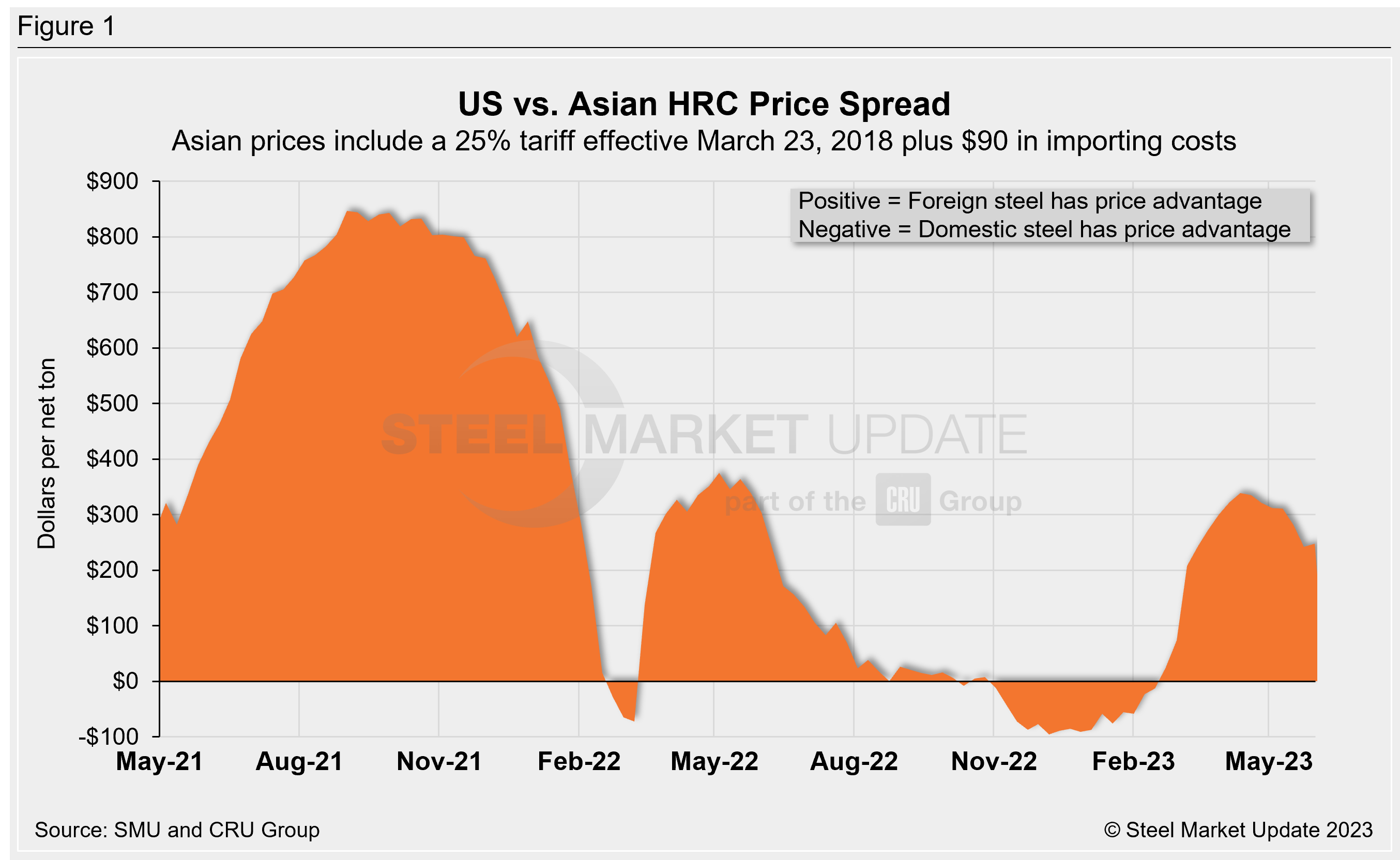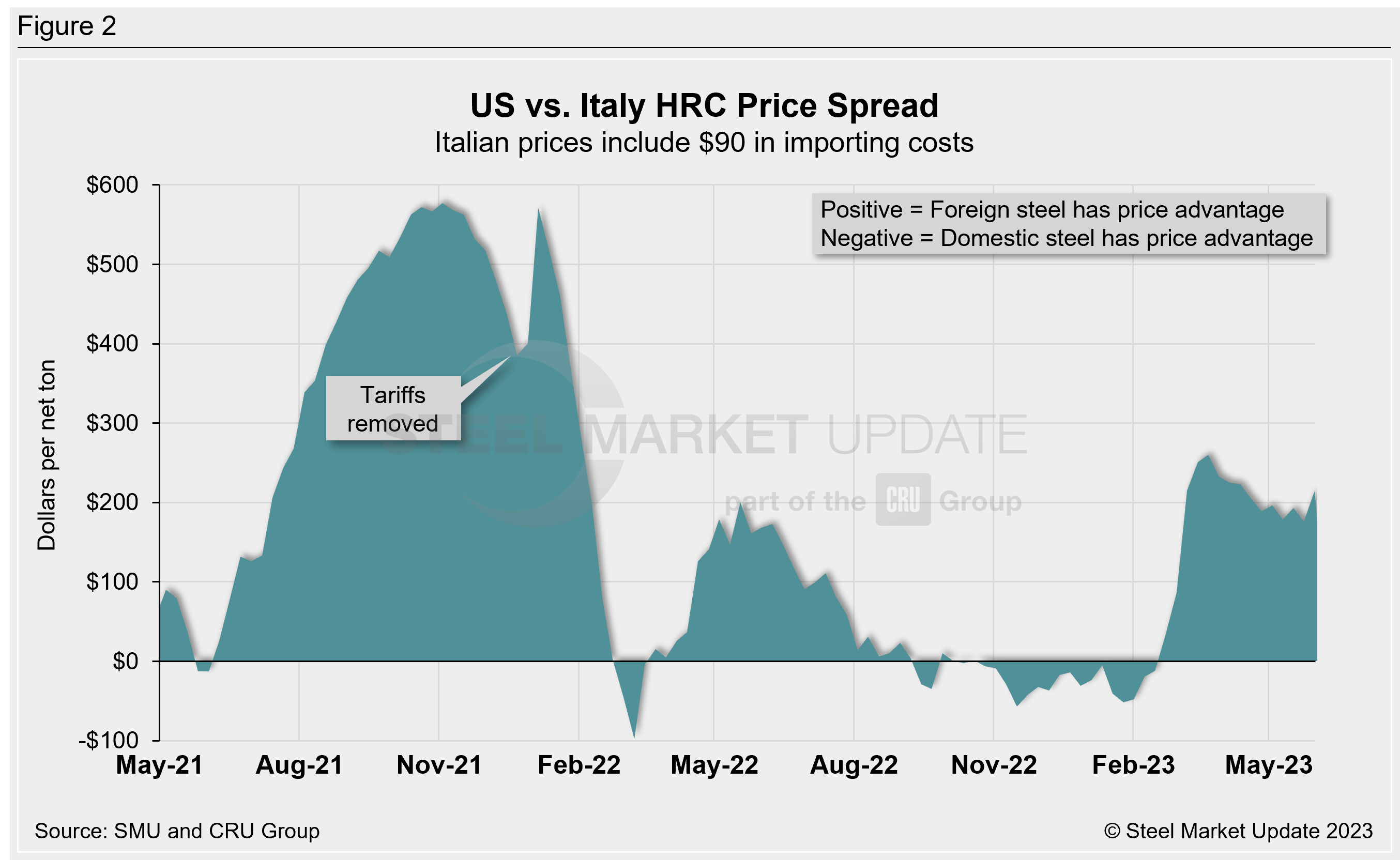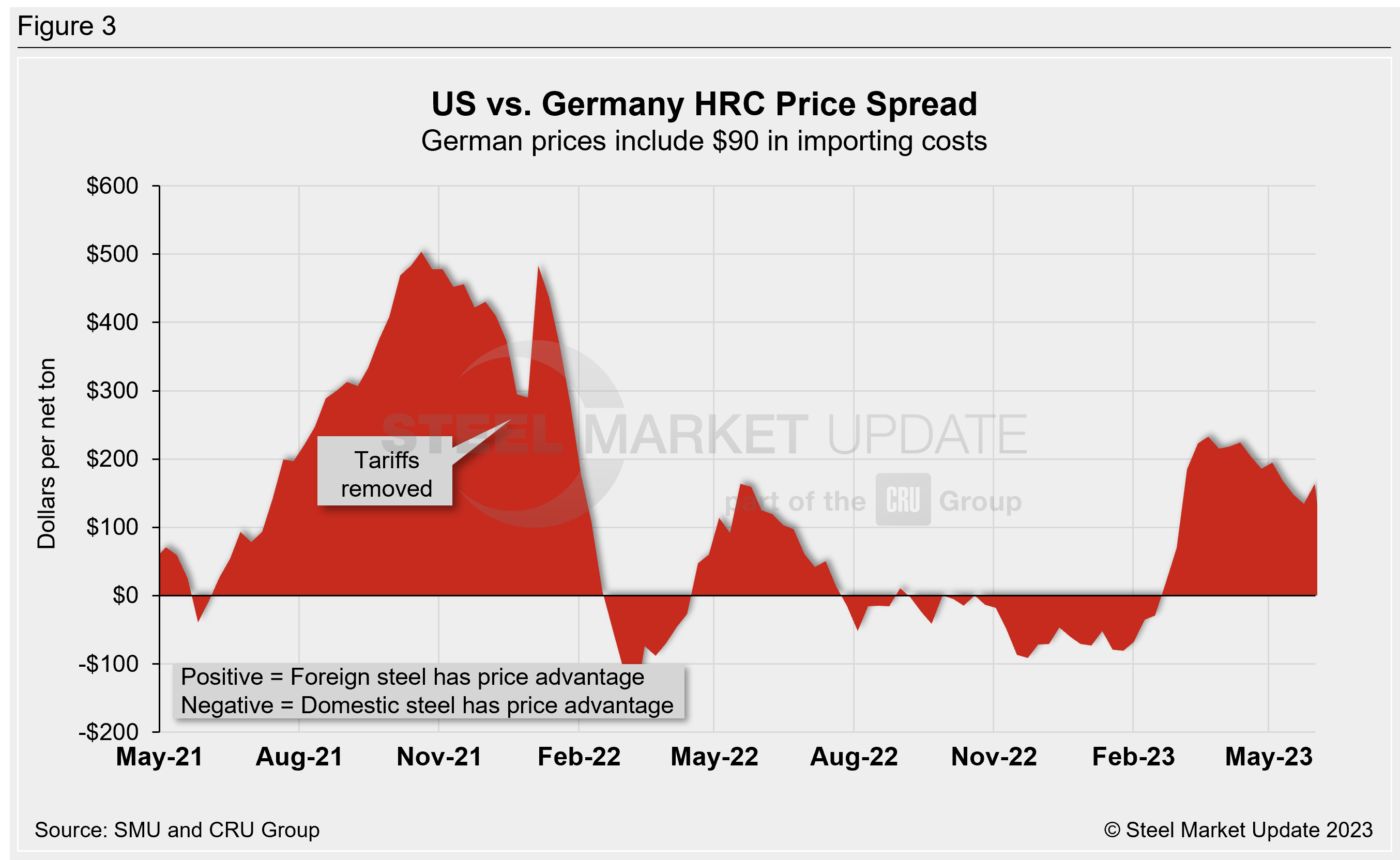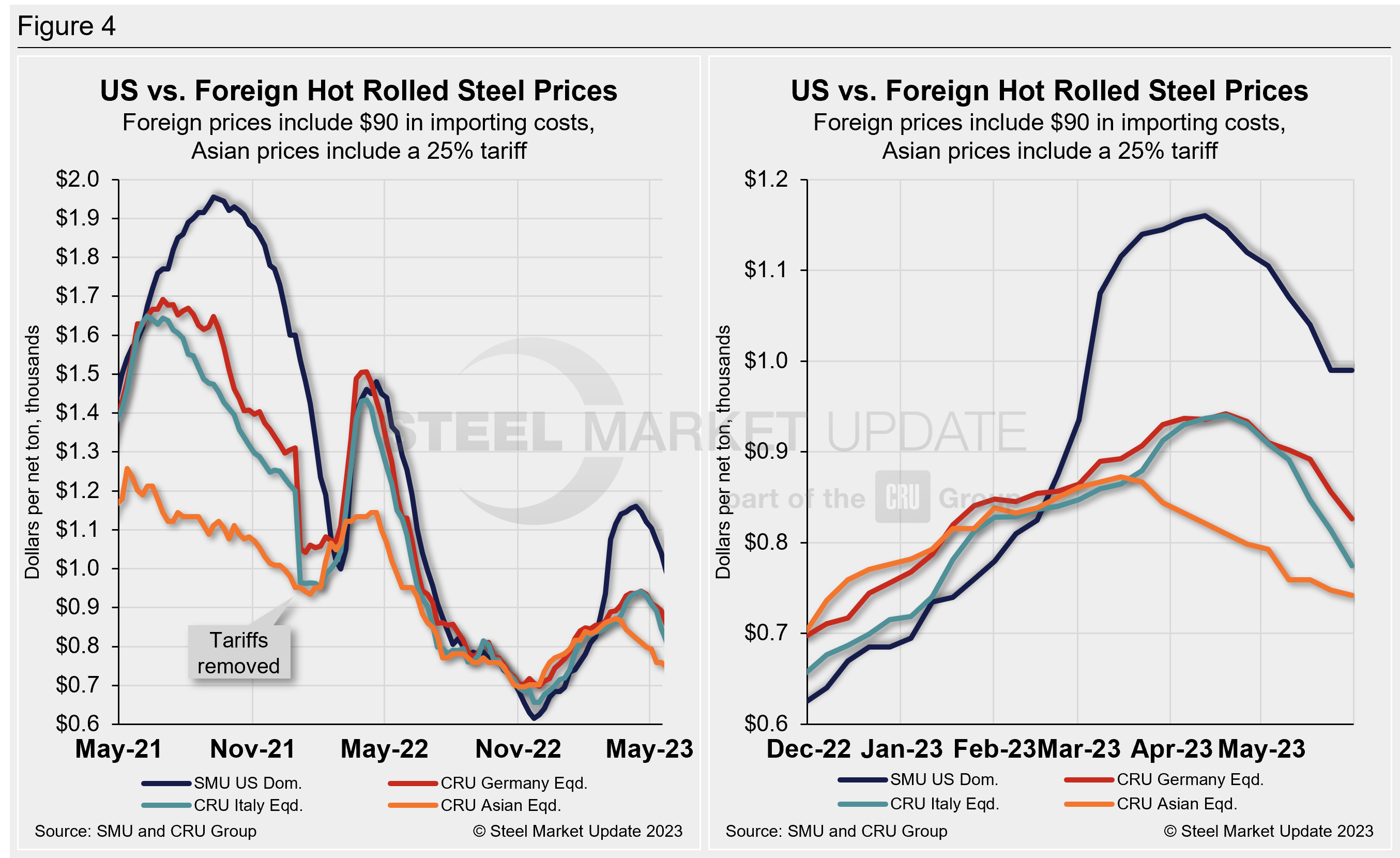Overseas

June 1, 2023
US Hot Band Keeps Premium Over Imports in Falling Market
Written by David Schollaert
Hot-rolled coil (HRC) imports remain at a discount to domestic hot band tags as both offshore and US product continue to decline at a similar rate, according to SMU’s latest foreign vs. domestic price analysis.
![]() Even as domestic tags have been on a seven-week decline, HRC imports have fallen at a comparable rate, keeping US hot band markedly more expensive than imported product.
Even as domestic tags have been on a seven-week decline, HRC imports have fallen at a comparable rate, keeping US hot band markedly more expensive than imported product.
Domestic HRC enjoyed a price advantage over imported material for nearly four months, but that turned negative in a hurry halfway through the first quarter when US tags soared on the back of repeated mill price hikes. And while the trend has reversed and stateside hot band prices are easing quickly, so are tags abroad, keeping the price margin between domestic and offshore product largely unchanged.
Domestic hot band is now roughly 21% more expensive than foreign material. That premium is marginally higher than last week when domestic HRC was 18.6% more costly than imported product.
US prices had been cheaper than foreign prices for the three regions we follow (Asia, Italy, and Germany) since the beginning of November after adding freight costs, trader margins, and applicable tariffs. That changed when US HRC prices jumped by more than $400 per ton from early February through mid-April. But US prices inflected and are now down for seven consecutive weeks, declining by $170 over that span.
Domestic HRC cost on average $18 per ton less than imported hot band as recently as Feb. 15. That flipped mid-Q1, with US prices ballooning to be$262 per ton more expensive than offshore product mid-way through April. The premium is now down $53 per ton, as domestic prices are on average $209 per ton more expensive than imported hot band.
SMU uses the following calculation to identify the theoretical spread between foreign HRC prices (delivered to US ports) and domestic HRC prices (FOB domestic mills): Our analysis compares the SMU US HRC weekly index to the CRU HRC weekly indices for Germany, Italy, and east and southeast Asian ports. This is only a theoretical calculation because costs to import can vary greatly, influencing the true market spread.
In consideration of freight costs, handling, and trader margin, we add $90 per ton to all foreign prices to provide an approximate CIF US ports price to compare to the SMU domestic HRC price. Buyers should use our $90-per-ton figure as a benchmark and adjust up or down based on their own shipping and handling costs. If you import steel and want to share your thoughts on these costs, we welcome your insight at david@steelmarketupdate.com.
Asian Hot-Rolled Coil (East and Southeast Asian Ports)
As of Thursday, June 1, the CRU Asian HRC price was down $4 per ton week-on-week (WoW) to $522 per ton, and down $41 per ton from levels one month prior. Adding a 25% tariff and $90 per ton in estimated import costs, the delivered price of Asian HRC to the US is approximately $742 per ton. The latest SMU hot rolled average is $990 per ton, down $50 per ton from our previous price update, and down $115 per ton compared to our price one month ago.
US-produced HRC is now theoretically $248 per ton more expensive than steel imported from Asia. That figure is down $6 per ton WoW. This is still a reversal from mid-February when domestic HRC had a $13-per-ton advantage over HRC from Asian markets.

Italian Hot-Rolled Coil
Italian HRC prices decreased WoW by $39 per ton to $685 per ton this week, and are down $134 per ton MoM. After adding import costs, the delivered price of Italian HRC is approximately $775 per ton.
Domestic HRC is now theoretically $215 per ton more expensive than imported Italian HRC. That spread is up $39 per ton WoW and still represents a nearly $227-per-ton reversal compared to just a little over three months ago when US HRC was $12 per ton cheaper than Italian hot band.

German Hot-Rolled Coil
CRU’s latest German HRC price slipped by $30 per ton WoW to $736 per net ton, down $84 per ton MoM. After adding import costs, the delivered price of German HRC is roughly $826 per ton.
Domestic HRC is now theoretically $164 per ton more expensive than imported German HRC. That’s up $30 per ton WoW still a swing of $193 per ton given that German hot band was $29 per ton more costly than domestic HRC in mid-February.

Figure 4 compares all four price indices and highlights the effective date of the tariffs. The chart on the left shows historical variation from Jan. 1, 2021, through present. The chart on the right zooms in to highlight the recent decoupling of US and offshore HRC prices.

Notes: Freight is an important consideration in deciding whether to import foreign steel or buy from a domestic mill. Domestic prices are referenced as FOB the producing mill, while foreign prices are CIF the port (Houston, NOLA, Savannah, Los Angeles, Camden, etc.). Inland freight, from either a domestic mill or from the port, can dramatically impact the competitiveness of both domestic and foreign steel. It’s also important to factor in lead times. In most markets, domestic steel will deliver more quickly than foreign steel.
Effective Jan. 1, 2022, the traditional Section 232 tariff no longer applies to most imports from the European Union. it has been replaced by a tariff rate quota (TRQ). Therefore, the German and Italian price comparisons in this analysis no longer include a 25% tariff. SMU still includes the 25% Section 232 tariff on foreign prices from other countries. We do not include any antidumping (AD) or countervailing duties (CVD) in this analysis.
By David Schollaert, david@steelmarketupdate.com







